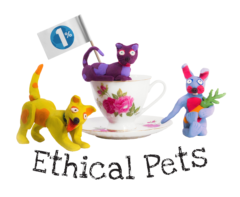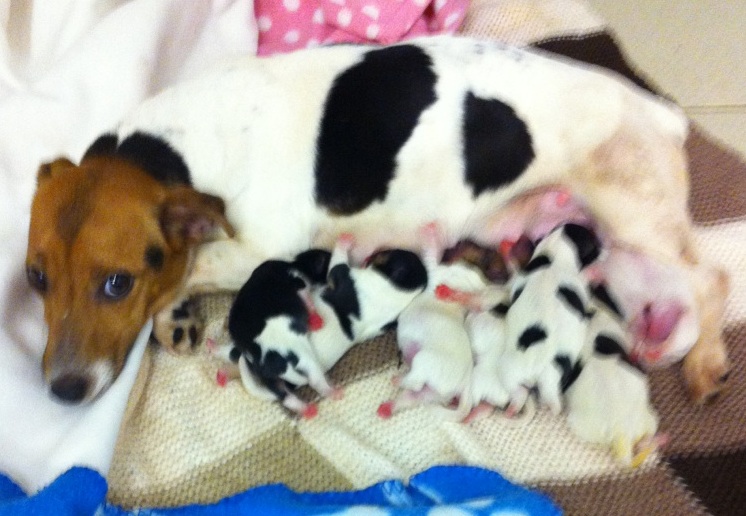 Ever wondered “What’s the point Organic food?” It is about health? Or about the environment? Why should I buy Organic pet food, my pet can’t tell the difference… Well here is the lowdown: The Objectives of Organic!
Ever wondered “What’s the point Organic food?” It is about health? Or about the environment? Why should I buy Organic pet food, my pet can’t tell the difference… Well here is the lowdown: The Objectives of Organic!
Category: Puppy
Shep: Reporting Live Vol.1
Shep recently interviewed Sarah Graham, Communications Assistant at The Dogs Trust. Here is a full transcript.
 Christmas was fun for me, I slept by the fire mostly. What do the dogs in Dogs Trust sanctuaries do at Christmas?
Christmas was fun for me, I slept by the fire mostly. What do the dogs in Dogs Trust sanctuaries do at Christmas?
 Once they are all cleaned and fed, all the dogs go for lovely long walk. Staff spend all day with the dogs to make sure they all enjoy their day and get lots of fuss and attention. All the dogs will also get a special treat out of their stocking – a special chew or a toy. All the dogs have stockings and the sponsored dogs proudly display their Christmas Cards from their sponsors. There is a Christmas tree in reception and the staff wear festive Santa hats.
Once they are all cleaned and fed, all the dogs go for lovely long walk. Staff spend all day with the dogs to make sure they all enjoy their day and get lots of fuss and attention. All the dogs will also get a special treat out of their stocking – a special chew or a toy. All the dogs have stockings and the sponsored dogs proudly display their Christmas Cards from their sponsors. There is a Christmas tree in reception and the staff wear festive Santa hats.
So do people still get Dogs for Christmas (and not for life?)
 I’m afraid so. 34 years ago Dogs Trust created the famous slogan “A Dog is for Life, Not Just for Christmas” – but sadly it appears that many people still buy dogs as presents without proper thought being given to the responsibilities involved. Each year we see around 100 dogs dumped at our re-homing centres over the Christmas period. We regret to say that 2012 was no different. It seems that people are still giving puppies as Christmas presents without considering the long term ramifications. Dogs can provide a world of happiness and enjoyment, and we urge anyone considering a new addition to the family to ‘think life’ and carefully consider the individual needs of the dog’s breed too.
I’m afraid so. 34 years ago Dogs Trust created the famous slogan “A Dog is for Life, Not Just for Christmas” – but sadly it appears that many people still buy dogs as presents without proper thought being given to the responsibilities involved. Each year we see around 100 dogs dumped at our re-homing centres over the Christmas period. We regret to say that 2012 was no different. It seems that people are still giving puppies as Christmas presents without considering the long term ramifications. Dogs can provide a world of happiness and enjoyment, and we urge anyone considering a new addition to the family to ‘think life’ and carefully consider the individual needs of the dog’s breed too.
 Where do all the Christmas dogs come from?
Where do all the Christmas dogs come from?
 Sadly one of the most popular places to buy dogs is online. Dogs Trust acknowledges that the Internet is an accessible way of purchasing gifts quickly, but the impulse buying of pets and animals poses the enormous risk of attracting many unscrupulous breeders. Consumers could, unintentionally, end up purchasing a pet from a puppy farm that has been trafficked into the UK. Such puppies often have physical and behavioral problems as a result of poor breeding conditions and traumatic transportation. To help prevent people thoughtlessly buying or giving a dog as Christmas present, Dogs Trust centers did not re-home dogs between the 22nd and 29th of December (22nd December to 2nd January in Scotland). People were still able to visit and reserve a dog, but were not be able to take it home until the New Year
Sadly one of the most popular places to buy dogs is online. Dogs Trust acknowledges that the Internet is an accessible way of purchasing gifts quickly, but the impulse buying of pets and animals poses the enormous risk of attracting many unscrupulous breeders. Consumers could, unintentionally, end up purchasing a pet from a puppy farm that has been trafficked into the UK. Such puppies often have physical and behavioral problems as a result of poor breeding conditions and traumatic transportation. To help prevent people thoughtlessly buying or giving a dog as Christmas present, Dogs Trust centers did not re-home dogs between the 22nd and 29th of December (22nd December to 2nd January in Scotland). People were still able to visit and reserve a dog, but were not be able to take it home until the New Year
 Were there any Dogs Trust miracles this Christmas?
Were there any Dogs Trust miracles this Christmas?
 Dogs Trust Glasgow was broken into four times during the Christmas period. Not only did the charity lose equipment, but some of the dogs became very distressed by the trauma and the centre was forced to close for a short period of time. In the midst of this turmoil, however, a Christmas miracle took place as dedicated staff helped a three year old Jack Russell Terrier, called Josie, give birth to a litter of seven pups on Christmas eve. The pups are all doing really well and have all been reserved to go to their loving new homes when they are old enough.
Dogs Trust Glasgow was broken into four times during the Christmas period. Not only did the charity lose equipment, but some of the dogs became very distressed by the trauma and the centre was forced to close for a short period of time. In the midst of this turmoil, however, a Christmas miracle took place as dedicated staff helped a three year old Jack Russell Terrier, called Josie, give birth to a litter of seven pups on Christmas eve. The pups are all doing really well and have all been reserved to go to their loving new homes when they are old enough.
Here’s Josie and her pups, all doing well!
The Healthy Huskies
 A summary of a scientific study into vegetarian animal nutrition.
A summary of a scientific study into vegetarian animal nutrition.
What’s the short version?
In 2004, two teams of Huskies raced across Australia. One side of each team had been fed a veggie diet, while the other side ate meat. They did not run in circles (or die).
Cool! So tell me more….
This study, lead by Dr Wendy Brown, was deigned to see if hard-working dogs would become anaemic or ill if they ate only plant based food. Sled-racing presents a great opportunity for nutritional research because the dogs run in pairs – i.e. at the same speed, for the same distance, pulling the same weight. This level of experimental 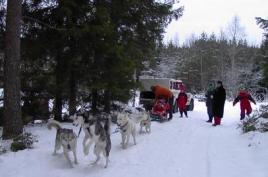 “control” is hard to achieve, and desire for it has lead to unethical practices in many types of research. What’s really great about this study is that the dogs were just “borrowed” – they are pets; not “lab-animals.”
“control” is hard to achieve, and desire for it has lead to unethical practices in many types of research. What’s really great about this study is that the dogs were just “borrowed” – they are pets; not “lab-animals.”
Dr Brown explains initially that the difference between meat and veggie food is bigger conceptually than it is nutritionally. Both non-meat and with-meat foods are usually made mostly of grain [8]. She says: “It is only a small step from some of the popular cereal-based dry dog foods to one that contains no meat at all.” [1]
The difference between meat and veggie food is bigger conceptually than it is nutritionally.
So, what happened in the experiment?
In this experiment, 12 Siberian huskies were divided into racing pairs based on ability. One of the dogs in each pair was fed on Pedigree Advantage, a food containing meat, made by Mars Petcare – who test on animals and use battery/barn eggs [2]. The other dog in the pair was fed on a vegetarian food, also developed by Mars Petcare Australia (especially for the experiment). [3] Take a look at Table One for a comparison of the ingredients – note how similar the foods are to each other. Both foods exceeded nutritional requirements/suggestions for dog food [4].

The racing season lasted 16 weeks, including training and recovery, and the dogs stayed in their usual environment and routine throughout. They were checked by a vet before hand, and then again in weeks 8 and 16. They had a blood test beforehand and then again in weeks 3, 8 and 16. The dog pairs raced in packs of 6 or 4, running 12 or 9 km races respectively.
What were the results?
In the race, the 6 dog team came in 4th place out of 29 packs, and the 4 dog team came in 7th place, from 36 packs….
No, not the race results! What were the blood test results?!
All the blood tests and vet checks showed normal results, for all of the dogs through all 16 weeks.
All the blood tests and vet checks showed normal results.
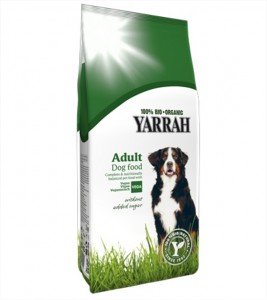 So, dogs can get enough protein from a veggie diet?
So, dogs can get enough protein from a veggie diet?
Yes, though scientists actually already knew this. Dr Brown suggests that, when taken in combination with data from previous studies, the results of this experiment highlight “the importance of providing sufficient dietary protein for exercising dogs, irrespective of whether the protein is of plant or animal origin.”
Does this mean that Vegetarian dog food is scientifically proven to be totally safe and complete?
No. It shows that veggie dog food can fulfill all the required “nutritional standards” in chemical terms [4]. It also shows that for short periods of time dogs wont suffer ill effects from eating a vegetarian diet – even if they are under considerable physical strain. This level of evidence, in my understanding, greatly surpasses that provided by most non-veggie pet food retailers, certainly most ethically minded ones anyway – yet it will probably not be considered enough evidence by many dog-lovers who find the concept of veggie dog food strange. For science to “decide” if vegetarian dog food is nutritionally equivalent to meat dog food, it will take many more investors, tests (perhaps inhumane) and dogs (perhaps in labs) – and much more time.
This level of evidence greatly surpasses that provided by most non-veggie pet food retailers.
So… why do Vegetarian pet foods say they are “nutritionally complete” on them?
It all comes down to methods and money. Dr Brown says: “Dog foods are tested for their nutritional adequacy in the first instance by means of chemical analysis. However, not all of the nutrients present in the dog food will necessarily be available to the dog.” In essence, when you grind up dog food, put it in a machine and look at the molecules it’s made from, vegetarian ingredients and meat ingredients are either the same or similar. However, that doesn’t mean that your dog is guaranteed to digest, absorb or use them in identical ways.
The foods can also be tested in a “feeding protocol” for more information – Dr Browns experiment is a very good and ethical example of such a test, however, normally such tests involve lab dogs. Also, these tests are expensive – out of reach for small, interested parties and not an attractive use of funds for large and disinterested parties.
So, if we decide to wait for categorical proof, how much meat will we feed to our dogs in the meantime?
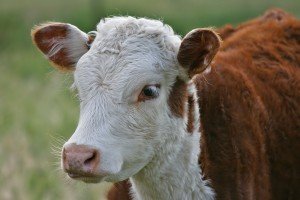 I did a little nerd-calculation – if the average dog eats about 164 kg of meat a year [5]; the average cow weighs about 700kg, and there are 74 million dogs in Europe [6] – meat to the “equivalent” of around 17 million cows will be farmed and killed every year to feed the dogs of Europe. What if it takes another 10, 15 or 20 years for science to reach a verdict? Should we feed the equivalent of another 240 million cows to our dogs in the meantime? Each year these 17 million cows would eat over 200 billion kilograms of vegetable protein [7]… and none of this takes into account the carbon footprint made by all that meat… nor the rain-forests cleared for the feed production… nor all the extra people who could have food if the west produced less meat…
I did a little nerd-calculation – if the average dog eats about 164 kg of meat a year [5]; the average cow weighs about 700kg, and there are 74 million dogs in Europe [6] – meat to the “equivalent” of around 17 million cows will be farmed and killed every year to feed the dogs of Europe. What if it takes another 10, 15 or 20 years for science to reach a verdict? Should we feed the equivalent of another 240 million cows to our dogs in the meantime? Each year these 17 million cows would eat over 200 billion kilograms of vegetable protein [7]… and none of this takes into account the carbon footprint made by all that meat… nor the rain-forests cleared for the feed production… nor all the extra people who could have food if the west produced less meat…
Logically, perhaps we should consider feeding our dogs on a plant-based diet until/unless science can tell us the food is nutritionally-incomplete!
Meat to the “equivalent” of 17 million cows is farmed and killed every year to feed the dogs of Europe.
And the conclusion?
Dr Brown says “[This] is the first study to demonstrate using a short feeding trail that a meat-free diet can be nutritionally adequate for exercising dogs. Whilst longer-term trials are necessary to prove this claim, nutritional adequacy was shown by chemical analysis, and this was further demonstrated by feeding the diet, in a controlled experiment, to actively exercising dogs…… these findings pave the way for commercial 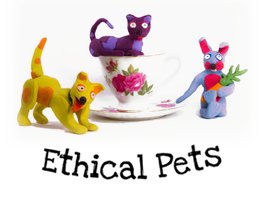 pet food manufactures to produce nutritionally adequate meat-free diets for dogs.”
pet food manufactures to produce nutritionally adequate meat-free diets for dogs.”
We say… here here!!
I’m convinced! Where can I buy vegetarian food for my dog?
I know a great little place on-line… I think it’s called “Ethical Pets” ; )
References
[1] This quote is from the first page of the article, which is numbered page 102. You can download the full study here.
[2] Sources for my claim that Mars conduct animal testing:
1) Ethical Consumer Magazine’s report into pet food, page 17/48. 2) Uncaged – unsure how reliable this source is as there are no references. 3) Mars Candy Kills – a glossy campaign with emotionally manipulative features and no references. This website states “Not one of Mars’ experiments on animals is required by law.” 4) The Mars Website says testing is meet legal requirements and that they “only conduct such animal research when non-animal alternatives are not feasible. Info from document entitled “Mars’ Position on Animal Welfare” dated 08/Sep/2011 accessed Feb 2012. Document is unnecessarily difficult to link to! 5) The Waltham Center for Pet Nutrition, owned by Mars. Glossy site, unclear language. Language and imagery seem manipulative, for example they call their test subjects “pets” and have subtle happy pet pictures in the background of their website.
[3] There was a feeding trial done, using the collection of dog faeces to establish “digestibility coefficients” at the university using dogs in their “Quarantine Approved Premises.” I assume in good faith this is not a lab, but a facility for animals which have been moved into the country as pets and require a legal examination etc. I await confirmation of this as I can find no exact information.
[4] In this case the standards set by the “National Research Council” were vastly exceeded by both foods. I (roughly) checked them against the current European equivalent at FEDIAF; they also surpassed this standard. Also note that it is likely these nutritional requirements have been discovered in experiments using vivisection.
[5] According to New Scientist, from Ethical Consumer Magazine’s report into pet food, page 17/48
[6] According to The European Pet Food Industry Federation: Facts and Figures, 2010
[7] As for each kg of beef produced, the cow needs to eat 17kg of vegetable protein From “saving the world with your knife and fork” by Juliet Gellatley in Resurgence, March/April 2012.
[8] From my understanding, these cereal-based foods need a high grain content for the “extrusion” process which shapes and cooks the biscuits/pellets. According to wikipedia, vitamin A is lost through extrusion – and potentially inadequate Vitamin A provision is one of the criticisms of specifically vegetarian pet food. Is meat pet food supplemented anyway, due to loss in this extrusion process?
Images:
By User Damast on sv.wikipedia (Photo by Damast) [GFDL (www.gnu.org/copyleft/fdl.html) or CC-BY-SA-3.0 (www.creativecommons.org/licenses/by-sa/3.0/)], via Wikimedia Commons.
By Jjron (Own work) [GFDL (www.gnu.org/copyleft/fdl.html) or CC-BY-SA-3.0 (www.creativecommons.org/licenses/by-sa/3.0/)], via Wikimedia Commons.
How not to entertain your puppy…
(ok, and how to as well…)
A guest blog from Alison Clayton-Smith
Bobby the Tibetan Terrier is coming up to 5 months old and yes he is very cute but he’s also very tetchy when he’s bored, which is pretty frequent (like every hour). Here are 3 lessons learnt on how not to entertain your puppy:

- Leaving work notes on the sofa
- Cleaning up wee in the house without removing him from the temptation of waggling tissues
- Wearing dangling necklaces, scarves, laces. In fact, pretty much wearing any clothing at all, though I have to admit, it would be more painful without the clothing barrier, and a bit chilly what with the doors being open so much to let him into the garden. (Top tip: never get a puppy in the winter months…)
Bobby loves digging up the garden to hide his hedgehogs and crocodiles.
There are better strategies and some of them even come with a good ethical pedigree, for example:
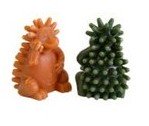
- Bobby loves digging up the garden to hide his hedgehogs and crocodiles. He likesme going with him. I tell myself it is in case he forgets and he is relying on me to remember, but I suspect that might be a bit of anthropomorphism going on there. At some point he’ll go back and dig them up, running triumphantly across the garden. He might eat a bit or he might just go and hide it somewhere else.
- An empty plastic bottle, clean and reasonably firm, makes a good toy to chase around. He had a particularly great time in the snow as the bottles slid across the surface. The only thing we have to watch is his little pincer teeth chewing the plastic off. In fact he’s pushing one round the lounge right now. If you’re outside and got neighbours, I don’t recommend giving them the bottle before 8am, it makes quite a racket.
- Cardboard tubes from toilet rolls, for example. I reckon he thinks our downstairs toilet is where cardboard tubes are made. Good for chewing, nosing around the carpet and sometimes hiding treats in, though he’s not great on the whole ‘Find’ thing yet.
- And finally, frozen carrots. I found this one on the Internet. Chop them up into chunks and freeze. Healthy snack, good for teething, and for some reason, fun to hunt. I’ve never thought of a carrot as prey. Works particularly well on a tiled/slippery surface where the carrot ‘escapes’ at every touch. Downside, Bobby does have a tendency to let them go mushy, which isn’t always nice for the carpet.
Ok, well he’s starting to get up to mischief so best be off!
